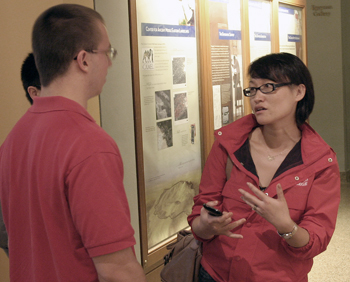
John Dykstra ’13 – Wabash students taking Mandarin and Chinese history classes had an engaging experience Sunday with Chinese culture. Professors Ssu-Yu Chou and Qian Zu Pullen led 31 students to Chinatown in Chicago.
The essence of the trip was for students to develop a better understanding of what “oriental” entails. Students were introduced to Chinese breakfast and dinner customs at traditional Chinese restaurants; visited The Oriental Institute; and had the opportunity to free roam and shop in Chinatown.
“Professor Chou and I have been planning this trip since the beginning of the semester,” Pullen said. “The purpose of this trip was for [students] to learn that oriental refers to more than China. ‘Oriental’ covers parts of Africa, the Middle East, and Asia.”
At The Oriental Institute, students viewed the Assyrian, Egyptian, Mesopotamian, Megiddo, Nubian, Persian, and Syro-Anatolian exhibits. Pursuing a degree in Asian Studies, Aaron Morton-Wilsonv’14 found more historical and cultural subjects to analyze through the museum.
“The trip is very interesting for me because it puts together a lot of things I have studied at Wabash, across multiple departments,” Morton-Wilson said. “Looking at The Oriental Institute, I got to learn about some of the ancient near-East history and I found that there is a connection between that history and the Chinese history that I can pursue as soon as I can.”
Students were fascinated by Chinese eating customs and cuisine. They particularly liked the breakfast custom of dipping a Chinese donut into warm soy milk and how there were several dishes on the table to choose from. The restaurants used a spinning plate in the center to help students serve themselves.
“The soy milk was divine,” Josh Manker ’14 said. “I have never had a fully immersed Chinese breakfast before.”
Vietnam native Hoan Nguyen noticed differences between Chinese and Vietnamese foods and eating customs.

“Chinese food and Vietnamese foods are different,” Nguyen said. “We eat different ways. For instance, for the fried donuts we had, [the Vietnamese] would dip them into soup rather than soy milk.”
Accustomed to American eating traditions, Lorenze Billups ’15 was captivated by how several Chinese dishes were shared using a spinning plate.
“I got to learn a lot about the Chinese culture,” Billups said. “The experience is the most intriguing part about it. You learn how things are done in Chinese culture, especially the sharing of the food. I thought that was most interesting. I am used to everyone having their own, separate plate; whereas, [in China] they bring out the dishes and everyone shares the dishes together.”
Pullen’s underlying lesson to students revolved around analyzing cultural differences.
“I wanted students to start to think about how to understand cultural differences,” she said. “We need to be sensitive to cultural differences to be respectful of various cultures since we all have some form of culture in common. That is one thing even I learned from this trip – that we all have similar cultural backgrounds.”